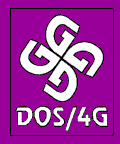DOS/4G
 | |
| Developer(s) | Tenberry Software |
|---|---|
| Stable release |
2.01
/ April 3, 1996[1] |
| Development status | Abandonware |
| Operating system | DOS |
| Platform | x86 |
| Type | DOS extender |
| License | Proprietary |
| Website |
www |
DOS/4G is a 32-bit DOS extender developed by Rational Systems (now Tenberry Software). It allows DOS programs to eliminate the 640 KB conventional memory limit by addressing up to 64[2] MB of extended memory on Intel 80386 and above machines.
Features
Functioning as a highly flexible and reusable memory extension library, DOS/4G allowed programmers to access extended memory without programming specialized code. It embeds itself in the executable file at linking time and executes before main application code, so usually DOS/4G initialization messages show up at launch. It can operate within MS-DOS, PC DOS, DR-DOS and other DOS clones, the DOS boxes of OS/2, Microsoft Windows, Windows NT and Windows 95, and DOS emulators such as DOSBox.
History
DOS/4GW was a free limited edition of DOS/4G and was included with the Watcom C compiler with a commercial re-distribution license. It was made widely popular by computer games like Doom.
Initial versions of DOS/4G had trouble with secondary DMA channels on the ISA bus, which prevented 16-bit devices like Gravis Ultrasound series from normally functioning; Gravis even had to develop a 'patch' utility which updated the game executable to work around this incompatibility.
In case of problems, DOS/4G or DOS/4GW can be replaced with the newer and free DOS/32; a patch utility can even replace DOS/4G code embedded inside a compiled executable file.[3]